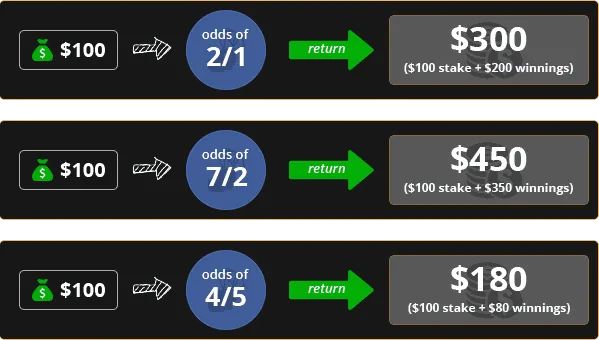Betting is a popular pastime that has been around for centuries. Whether it’s on sports events, horse races, or casino games, the thrill of placing a bet and potentially winning big is hard to resist. And one of the most common questions that many new bettors have is: if I bet $100, how much do I win? This may seem like a simple question, but it actually involves understanding odds formats, calculating implied probability, and potential profit. In this article, we’ll dive into the world of betting odds and break down the answer to this question in detail.

1. Understanding Different Odds Formats
Before we can answer how much you can win from a $100 bet, it’s important to understand the different odds formats that are used in betting. Depending on where you are located, you may come across American, Decimal, or Fractional odds. Each format has its own way of representing the potential payout for a bet. Let’s take a closer look at each one.
1.1 American (Moneyline) Odds
American odds, also known as moneyline odds, are commonly used in North America and are expressed as either a positive (+) or negative (-) value. Positive odds indicate that the potential payout will be more than your initial stake, while negative odds mean that the potential payout will be less than your initial stake. The odds are typically displayed in hundreds and thousands, allowing bettors to quickly see the potential payout for a $100 bet.
For example, let’s say you want to place a bet on an upcoming basketball game between the Los Angeles Lakers and Golden State Warriors. The odds for the Lakers to win are listed as +150, while the odds for the Warriors to win are listed as -200. This means that a $100 bet on the Lakers would potentially win you $150 (plus your initial $100 stake), while a $200 bet on the Warriors would potentially win you $100 (plus your initial $200 stake).
1.2 Decimal Odds
Decimal odds are popular in Europe and are considered to be the easiest format for calculating potential profits. Unlike American odds, the decimal format includes your initial stake in the potential payout. To calculate your potential profit from a decimal odd, simply multiply your stake by the decimal odd.
For example, let’s say you want to bet on an upcoming soccer match between FC Barcelona and Real Madrid. The odds for FC Barcelona to win are listed as 1.75. If you place a $100 bet on them and they win, your potential profit would be $175 (1.75 x $100).
1.3 Fractional Odds
Fractional odds are most commonly used in horse racing and futures markets. They are represented as a fraction, with the first number indicating the potential profit and the second number indicating the initial stake. For example, if the odds for a horse race are listed as 2/1, this means that you could potentially win $2 for every $1 you bet. If the odds are listed as 5/1, this means you could potentially win $5 for every $1 you bet.
2. Calculating Implied Probability and Potential Profit
Now that we understand the different odds formats, let’s take a look at how to calculate implied probability and potential profit. This information is important for making informed betting decisions and comparing odds from different bookmakers.
2.1 Implied Probability
Implied probability refers to the likelihood of an event occurring based on the odds provided. It is calculated by dividing 100 by the odds plus 100. This will give you a percentage, which represents the implied probability of the outcome happening.
For example, let’s say you want to bet on a boxing match between Floyd Mayweather and Manny Pacquiao. The odds for Mayweather to win are listed as -250, while the odds for Pacquiao to win are listed as +300. To calculate the implied probability of Mayweather winning, we would do the following calculation: 100 / (250 + 100) = 100/350 = 0.2857 or 28.57%. This means that according to the odds, there is a 28.57% chance of Mayweather winning the fight.
2.2 Potential Profit
To calculate the potential profit for a bet, you simply multiply your stake by the decimal odd or fraction. For American odds, this calculation is a little different. If the odds are positive, you divide the odds by 100 and then multiply by your stake. If the odds are negative, you divide 100 by the odds and then multiply by your stake.
Let’s look at an example using American odds. If you want to bet $100 on a tennis match between Roger Federer and Rafael Nadal, and the odds for Federer to win are listed as +150, your potential profit would be calculated as follows: (150 / 100) x $100 = $150. This means that if Federer wins, you could potentially win $150 in addition to your initial stake of $100.

3. The Importance of Using an Odds Converter
As we’ve seen, understanding different odds formats and calculating implied probability and potential profit can be quite complex. This is where an odds converter tool comes in handy. An odds converter allows you to quickly convert odds between American, Decimal, and Fractional formats. It also calculates the implied probability and potential profit for you, making it easier to compare odds from different bookmakers and make informed betting decisions.
One popular odds converter is Odds Shark’s Odds Converter. Let’s take a look at how it works using the same examples we’ve used throughout this article.
3.1 Converting American Odds
To convert American odds using Odds Shark’s converter, simply enter the odds in the appropriate field and click on the “Convert” button. Using our earlier example of the Los Angeles Lakers with +150 odds, we would input 150 in the American field and the tool will automatically display the equivalent odds in Decimal and Fractional formats. It also calculates the implied probability of the Lakers winning at 40%.
3.2 Converting Decimal Odds
To convert Decimal odds, you would input the odds in the Decimal field and click on “Convert”. For our example of FC Barcelona with odds of 1.75, the tool would show the equivalent American and Fractional odds, as well as the implied probability of 57.14%.
3.3 Converting Fractional Odds
For converting Fractional odds, you would input the odds in the Fractional field and click on “Convert”. Using our example of 5/1 odds for a horse race, the tool would display the equivalent American and Decimal odds, as well as the implied probability of 16.67%.
Using an odds converter can help you save time and avoid potential miscalculations when comparing odds from different sportsbooks.

4. Conclusion
In conclusion, the answer to the question “if I bet $100, how much do I win?” depends on the odds format, implied probability, and potential profit. Understanding these concepts is crucial for making informed betting decisions and comparing odds from different bookmakers. Using an odds converter tool can make this process easier and more efficient. So next time you’re placing a bet, be sure to keep all these factors in mind and use an odds converter to help guide your decision-making.
